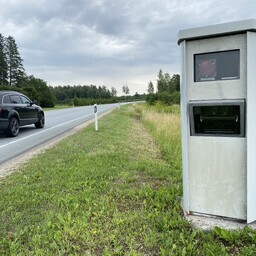2018. aastal olid
statsionaarsed kiiruskaamerad
kõige populaarsemad. Siis oli neid 48. Praegu on neid ainult 34. Transpordiameti juht Priit Sauk ütles, et
vanu kaameraid hooldatakse veel 3–7 aastat
. Uusi kaameraid ei osteta.
statsionaarsed kiiruskaamerad
Tõlge fraasile: statsionaarsed kiiruskaamerad
EN
stationary speed cameras
vanu kaameraid hooldatakse veel 3–7 aastat
Tõlge fraasile: vanu kaameraid hooldatakse veel 3–7 aastat
EN
old cameras will be maintained for another 3–7 years
Praegu teavad kõik, kus need kaamerad on. See ei ole väga tõhus. Politsei kasutab juba 8 mobiilset kiiruskaamerat. Need kaamerad tabavad palju kiiruseületajaid.
Politsei töötajad ei osta rohkem selliseid kaameraid. Nad tahavad arendada uut süsteemi – isemõõtvat patrullautot. See peaks valmima 2027. aastal.
Patrullauto tunneks ära palju rikkumisi. Näiteks
turvavööta sõitja
või
telefoniga juhit
. Sellised rikkumised saadetakse automaatselt
trahviteade
.
turvavööta sõitja
Tõlge fraasile: turvavööta sõitja
EN
driver without a seatbelt
telefoniga juhit
Tõlge fraasile: telefoniga juhit
EN
driver using a phone
trahviteade
Tõlge fraasile: trahviteade
EN
fine notice
Uute seadmete jaoks on vaja muuta seadusi. Politsei ei saa ise kaamerate eest maksta. Sellepärast ootavad nad poliitikute otsust.
Keskmise kiiruse kaamerad võiksid aidata
liiklusohutust
. Leedus on selliseid kaameraid palju. Eestis pole neid veel kasutusel. Selleks on vaja
poliitilist tahet
.
liiklusohutust
Tõlge fraasile: liiklusohutust
EN
traffic safety
poliitilist tahet
Tõlge fraasile: poliitilist tahet
EN
political will
In 2018, stationary speed cameras were the most popular. There were 48 of them then. Now there are only 34. The head of the Transport Board, Priit Sauk, said that the old cameras will be maintained for another 3-7 years. No new cameras will be purchased.
Everyone knows where these cameras are now. This is not very effective. The police are already using 8 mobile speed cameras. These cameras catch many speed violators.
Police officers will not buy more such cameras. They want to develop a new system—a self-monitoring patrol car. It is expected to be ready by 2027.
The patrol car would recognize many violations. For example, a driver without a seatbelt or using a phone. Such violations would automatically result in a fine notification.
New devices require changes in laws. The police cannot pay for the cameras themselves. Therefore, they are waiting for a decision from politicians.
Average speed cameras could help with traffic safety. There are many such cameras in Lithuania. They are not yet in use in Estonia. This requires political will.

